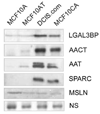Identification of differentially secreted biomarkers using LC-MS/MS in isogenic cell lines representing a progression of breast cancer
- PMID: 17608509
- PMCID: PMC2584611
- DOI: 10.1021/pr060629m
Identification of differentially secreted biomarkers using LC-MS/MS in isogenic cell lines representing a progression of breast cancer
Abstract
Proteins secreted (the secretome) from cancer cells are potentially useful as biomarkers of the disease. Using LC-MS/MS, the secreted proteomes from a series of isogenic breast cancer cell lines varying in aggressiveness were analyzed by mass spectrometry: nontumorigenic MCF10A, premalignant/tumorigenic MCF10AT, tumorigenic/locally invasive MCF10 DCIS.com, and tumorigenic/metastatic MCF 10CA cl. D. Proteomes were obtained from conditioned serum-free media, partially fractionated using a small reverse phase C2 column, and digested with trypsin for analysis by LC-MS/MS, using a method previously shown to give highly enriched secreted proteomes (Mbeunkui et al. J. Proteome Res. 2006, 5, 899-906). The search files produced from five analyses (three separate preparations) were combined for database searching (Mascot) which produced a list of over 250 proteins from each cell line. The aim was to discover highly secreted proteins which changed significantly in abundance corresponding with aggressiveness. The most apparent changes were observed for alpha-1-antichymotrypsin and galectin-3-binding protein which were highly secreted proteins from MCF10 DCIS.com and MCF10CA cl. D, yet undetected in the MCF10A and MCF10AT cell lines. Other proteins showing increasing abundance in the more aggressive cell lines included alpha-1-antitrypsin, cathepsin D, and lysyl oxidase. The S100 proteins, often associated with metastasis, showed variable changes in abundance. While the cytosolic proteins were low (e.g., actin and tubulin), there was significant secretion of proteins often associated with the cytoplasm. These proteins were all predicted as products of nonclassical secretion (SecretomeP, Center for Biological Sequence Analysis). The LC-MS/MS results were verified for five selected proteins by western blot analysis, and the relevance of other significant proteins is discussed. Comparisons with two other aggressive breast cancer cell lines are included. The protein with consistent association with aggressiveness in all lines, and in unrelated cancer cells, was the galectin-3-binding protein which has been associated with breast, prostate, and colon cancer earlier, supporting the approach and findings. This analysis of an isogenic series of cell lines suggests the potential usefulness of the secretome for identifying prospective markers for the early detection and aggressiveness/progression of cancer.
Figures



Similar articles
-
Mass spectrometry (LC-MS/MS) identified proteomic biosignatures of breast cancer in proximal fluid.J Proteome Res. 2012 Oct 5;11(10):5034-45. doi: 10.1021/pr300606e. Epub 2012 Sep 20. J Proteome Res. 2012. PMID: 22934887 Free PMC article.
-
Proteomic Analysis of Urine to Identify Breast Cancer Biomarker Candidates Using a Label-Free LC-MS/MS Approach.PLoS One. 2015 Nov 6;10(11):e0141876. doi: 10.1371/journal.pone.0141876. eCollection 2015. PLoS One. 2015. PMID: 26544852 Free PMC article.
-
Comparative membrane proteomics analyses of breast cancer cell lines to understand the molecular mechanism of breast cancer brain metastasis.Electrophoresis. 2017 Sep;38(17):2124-2134. doi: 10.1002/elps.201700027. Epub 2017 Jul 5. Electrophoresis. 2017. PMID: 28523741
-
The cancer secretome, current status and opportunities in the lung, breast and colorectal cancer context.Biochim Biophys Acta. 2013 Nov;1834(11):2242-58. doi: 10.1016/j.bbapap.2013.01.029. Epub 2013 Jan 31. Biochim Biophys Acta. 2013. PMID: 23376433 Review.
-
Secretome Proteomic Approaches for Biomarker Discovery: An Update on Colorectal Cancer.Medicina (Kaunas). 2020 Aug 31;56(9):443. doi: 10.3390/medicina56090443. Medicina (Kaunas). 2020. PMID: 32878319 Free PMC article. Review.
Cited by
-
Functional characterization of the progestagen-associated endometrial protein gene in human melanoma.J Cell Mol Med. 2010 Jun;14(6B):1432-42. doi: 10.1111/j.1582-4934.2009.00922.x. Epub 2009 Oct 3. J Cell Mol Med. 2010. PMID: 19799645 Free PMC article.
-
Phenotypic and Molecular Characterization of MCF10DCIS and SUM Breast Cancer Cell Lines.Int J Breast Cancer. 2013;2013:872743. doi: 10.1155/2013/872743. Epub 2013 Jan 16. Int J Breast Cancer. 2013. PMID: 23401782 Free PMC article.
-
iTRAQ identification of candidate serum biomarkers associated with metastatic progression of human prostate cancer.PLoS One. 2012;7(2):e30885. doi: 10.1371/journal.pone.0030885. Epub 2012 Feb 15. PLoS One. 2012. PMID: 22355332 Free PMC article.
-
Metabolic signature of eyelid basal cell carcinoma.Exp Eye Res. 2020 Sep;198:108140. doi: 10.1016/j.exer.2020.108140. Epub 2020 Jul 7. Exp Eye Res. 2020. PMID: 32649951 Free PMC article.
-
Silence of α1-Antitrypsin Inhibits Migration and Proliferation of Triple Negative Breast Cancer Cells.Med Sci Monit. 2018 Sep 27;24:6851-6860. doi: 10.12659/MSM.910665. Med Sci Monit. 2018. PMID: 30260937 Free PMC article.
References
-
- Flagg EW, et al. Validation of the American Cancer Society Cancer Prevention Study II Nutrition Survey Cohort Food Frequency Questionnaire. Epidemiology. 2000;11(4):462–468. - PubMed
-
- Ruoslahti E. Fibronectin and its integrin receptors in cancer. Adv Cancer Res. 1999;76:1–20. - PubMed
-
- Mbeunkui F, Fodstad O, Pannell LK. Secretory protein enrichment and analysis: an optimized approach applied on cancer cell lines using 2D LC-MS/MS. J Proteome Res. 2006;5(4):899–906. - PubMed
-
- Hunter T. Oncoprotein networks. Cell. 1997;88(3):333–346. - PubMed
Publication types
MeSH terms
Substances
Grants and funding
LinkOut - more resources
Full Text Sources
Other Literature Sources
Medical
Miscellaneous

